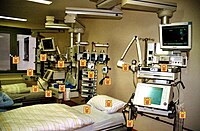
Photo from wikipedia
Background Nursing professional organizations and media sources indicated early in the pandemic that the physical and psychological effects of COVID-19 might be distinct and possibly greater in nurses than in… Click to show full abstract
Background Nursing professional organizations and media sources indicated early in the pandemic that the physical and psychological effects of COVID-19 might be distinct and possibly greater in nurses than in other types of healthcare workers (HCWs). Objectives Based on survey data collected in Healthcare Worker Exposure Response and Outcomes (HERO), a national registry of U.S. HCWs, this study compared the self-reported experiences of nurses with other HCWs during the first 13 months of the pandemic. Methods Nurse responses were compared to responses of nonnurse HCWs in terms of viral exposure, testing and infection, access to personal protective equipment (PPE), burnout, and well-being. Logistic regression models were used to examine associations between nurse and nonnurse roles for the binary end points of viral testing and test positivity for COVID-19. We also examined differences by race/ethnicity and high-risk versus low-risk practice settings. Results Of 24,343 HCWs in the registry, one third self-identified as nurses. Nurses were more likely than other HCWs to report exposure to SARS-CoV-2, problems accessing PPE, and decreased personal well-being, including burnout, feeling tired, stress, trouble sleeping, and worry. In adjusted models, nurses were more likely than nonnurse HCWs to report viral testing and test positivity for COVID-19 infection. Nurses in high-risk settings were more likely to report viral exposure and symptoms related to well-being; nurses in low-risk settings were more likely to report viral testing and test positivity. Black or Hispanic nurses were most likely to report test positivity. Discussion Differences were identified between nurses and nonnurse HCWs in access to PPE, physical and mental well-being measures, and likelihood of reporting exposure and infection. Among nurses, testing and infection differed based on race and ethnicity, and type of work setting. Our findings suggest further research and policy are needed to elucidate and address social and occupational disparities.
Journal Title: Nursing Research
Year Published: 2022
Link to full text (if available)
Share on Social Media: Sign Up to like & get
recommendations!